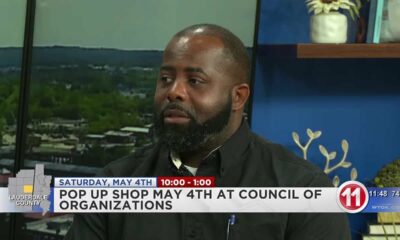Kaiser Health News
California’s Fentanyl Problem Is Getting Worse
by Don Thompson
Tue, 23 May 2023 09:00:00 +0000
California has allocated more than $1 billion in recent years to combat its opioid crisis. Much of the money has been used to distribute fentanyl test strips and the overdose reversal drug naloxone, as well as deliver medical care to people who are homeless. The state has an opioid awareness campaign tailored to youths and recently called on the National Guard to help detect drug traffickers.
Yet the problem keeps getting worse.
Driven largely by the prevalence of fentanyl, a synthetic opioid up to 100 times stronger than morphine, drug overdoses in California now kill more than twice as many people as car accidents, more than four times as many as homicides, and more than either diabetes or lung cancer, according to California Health Policy Strategies, a Sacramento consulting group. And the state's overdose surveillance dashboard indicates most opioid overdose deaths involve fentanyl.
Provisional data for last year from the Centers for Disease Control and Prevention shows a small annual increase in overdose deaths in California, to nearly 12,000. Across the U.S., overdose deaths again topped 100,000.
“As a parent, it scares the hell out of me. As a governor, I see it, I recognize the nature of what's occurred on the streets,” Gov. Gavin Newsom said May 12 in announcing more funding for California to produce its own naloxone.
Despite all the state is doing to reduce drug overdose deaths, public health policy experts say there are no easy or clear answers. Drug policy experts applaud California's effort to make naloxone as commonly available as fire extinguishers in schools, bars, libraries, and gas stations, but they also recommend diverting more offenders from prisons and jails into treatment and encourage ramping up the use of anti-addiction medication.
“Even if we do a lot of things right in policy, we're going to have a fair amount of deaths in the coming years,” said Keith Humphreys, a professor of psychiatry and behavioral sciences at Stanford University and a drug policy expert.
He said lawmakers should examine the underlying, complex causes of addiction if they want to make lasting change. Lawmakers have created a Select Committee on Fentanyl, Opioid Addiction, and Overdose Prevention and are advancing a bill to create a Fentanyl Addiction and Overdose Prevention Task Force. The bill would require the task force to start meeting next year and submit an interim report by January 2025 and recommendations by July 2025.
“It really is something, like covid, that we have to focus on and make some permanent structural changes, like to health care, mental health care, and funding to deal with addiction,” Humphreys said.
Newsom acknowledged as much, saying, “We have a lot more work to do.”
The Democratic governor was joined last month by Attorney General Rob Bonta in calling on the California National Guard, California Highway Patrol, and state Department of Justice to crack down on fentanyl dealing in San Francisco, where fatal overdoses jumped more than 40% in the first three months of this year over 2022.
The move was criticized as “a law enforcement-first approach to matters of public health” in a joint statement from 28 organizations including the American Civil Liberties Union of Northern California and the San Francisco Public Defender's Office.
While the governor has focused on fentanyl trafficking and making naloxone more readily available, state lawmakers have recently been debating whether and how to stiffen punishments for dealers.
Several proposals have already stalled, such as one to send dealers to jail for up to nine years if they sell fentanyl on a social media platform and another warning dealers they could be charged with murder if someone dies taking their drugs. Lawmakers kept alive two bills to boost punishments for dealers of large volumes of fentanyl and those who carry a gun.
Democrats who control the legislature's public safety committees are reluctant to support tougher penalties for fear of sparking a new war on drugs or reprising steep penalties on crack cocaine that criminalized Black people disproportionately.
Black and Latino Californians experienced an increase in overdose deaths of more than 200% between 2017 and 2021, according to Konrad Franco, who conducted the research for California Health Policy Strategies. Black people make up 6% of California's population but accounted for 13% of its overdose deaths in 2021.
“We cannot go backwards and fill our prisons with kids of color,” said Assemblymember Liz Ortega, a Democrat from San Leandro, during a special hearing last month on fentanyl-related bills.
Georges Benjamin, executive director of the American Public Health Association, questioned the effectiveness of increased penalties for people who are largely controlled by their addictions.
Benjamin said lawmakers should instead support drug courts that promote treatment programs over incarceration, though he said incarceration may be needed to protect the public mostly from violent offenders who refuse treatment and harm others.
Humphreys pointed to the Honest Opportunity Probation With Enforcement and 24/7 Sobriety programs as models. They combine regularly testing offenders for drugs and alcohol with short penalties for violations.
“You use the criminal justice system in a way that in the long run actually reduces incarceration rather than increasing it,” Humphreys said of the approach.
Yet Tanya Tilghman, a Black woman from San Francisco, supports tougher penalties for fentanyl dealers and said the issue crosses racial lines. She became an activist with Mothers Against Drug Addiction and Deaths after her son became addicted to methamphetamine and more recently to fentanyl.
“When people are doing drugs, it doesn't see color or racial boundaries,” she said. “It's killing a lot more people and it's killing a lot of Black people.”
Daniel Ciccarone, a drug policy expert at the University of California-San Francisco, said enforcement efforts may be popular with the public but “simply don't work as well as we want them to.” At minimum, he said, any crackdown should be coupled with an equal public health approach.
“We've thrown tens of billions of dollars at the war on drugs over two generations, almost three generations now, and believe it or not, drugs across category — from marijuana to cocaine to heroin/fentanyl — drugs are ever more pure and ever cheaper despite impressive levels of effort,” Ciccarone said. “The most honest answer is there's no clear answer as to what to do about the fentanyl crisis.”
He recommended California allow supervised consumption sites where opioid users could legally inject drugs, an idea Newsom vetoed last fall but that Ciccarone said can ease people into treatment. Other harm reduction strategies, including expanding the use of test strips and other chemical analyses to check drugs for contamination with fentanyl, can also save lives, he said.
Humphreys led a 17-member commission that examined the opioid crisis and made recommendations including expanding the availability of prescription drugs such as buprenorphine, naltrexone, and methadone to ease addicts' cravings and withdrawal symptoms.
Still, some parents of children who have experienced opioid addiction say tougher penalties must be part of the response.
“What they don't understand is that fentanyl has changed the drug landscape like no other drug has in the history of the United States of America,” said Jaime Puerta, whose only son, Daniel, died from fentanyl in 2020 at age 16.
This article was produced by KFF Health News, which publishes California Healthline, an editorially independent service of the California Health Care Foundation.
KFF Health News is a national newsroom that produces in-depth journalism about health issues and is one of the core operating programs at KFF—an independent source of health policy research, polling, and journalism. Learn more about KFF.
USE OUR CONTENT
This story can be republished for free (details).
By: Don Thompson
Title: California's Fentanyl Problem Is Getting Worse
Sourced From: kffhealthnews.org/news/article/california-fentanyl-problem-getting-worse/
Published Date: Tue, 23 May 2023 09:00:00 +0000
Did you miss our previous article…
https://www.biloxinewsevents.com/he-returned-to-the-us-for-his-daughters-wedding-he-left-with-a-42000-hospital-bill/
Kaiser Health News
Genetics Studies Have a Diversity Problem That Researchers Struggle To Fix
Lauren Sausser
Thu, 25 Apr 2024 09:00:00 +0000
CHARLESTON, S.C. — When he recently walked into the dental clinic at the Medical University of South Carolina donning a bright-blue pullover with “In Our DNA SC” embroidered prominently on the front, Lee Moultrie said, two Black women stopped him to ask questions.
“It's a walking billboard,” said Moultrie, a health care advocate who serves on the community advisory board for In Our DNA SC, a study underway at the university that aims to enroll 100,000 South Carolinians — including a representative percentage of Black people — in genetics research. The goal is to better understand how genes affect health risks such as cancer and heart disease.
Moultrie, who is Black and has participated in the research project himself, used the opportunity at the dental clinic to encourage the women to sign up and contribute their DNA. He keeps brochures about the study in his car and at the barbershop he visits weekly for this reason. It's one way he wants to help solve a problem that has plagued the field of genetics research for decades: The data is based mostly on DNA from white people.
Project leaders in Charleston told KFF Health News in 2022 that they hoped to enroll participants who reflect the demographic diversity of South Carolina, where just under 27% of residents identify as Black or African American. To date, though, they've failed to hit that mark. Only about 12% of the project's participants who provided sociodemographic data identify as Black, while an additional 5% have identified as belonging to another racial minority group.
“We'd like to be a lot more diverse,” acknowledged Daniel Judge, principal investigator for the study and a cardiovascular genetics specialist at the Medical University of South Carolina.
Lack of diversity in genetics research has real health care implications. Since the completion more than 20 years ago of the Human Genome Project, which mapped most human genes for the first time, close to 90% of genomics studies have been conducted using DNA from participants of European descent, research shows. And while human beings of all races and ancestries are more than 99% genetically identical, even small differences in genes can spell big differences in health outcomes.
“Precision medicine” is a term used to describe how genetics can improve the way diseases are diagnosed and treated by considering a person's DNA, environment, and lifestyle. But if this emerging field of health care is based on research involving mostly white people, “it could lead to mistakes, unknowingly,” said Misa Graff, an associate professor in epidemiology at the University of North Carolina and a genetics researcher.
In fact, that's already happening. In 2016, for example, research found that some Black patients had been misdiagnosed with a potentially fatal heart condition because they'd tested positive for a genetic variant thought to be harmful. That variant is much more common among Black Americans than white Americans, the research found, and is considered likely harmless among Black people. Misclassifications can be avoided if “even modest numbers of people from diverse populations are included in sequence databases,” the authors wrote.
The genetics research project in Charleston requires participants to complete an online consent form and submit a saliva sample, either in person at a designated lab or collection event or by mail. They are not paid to participate, but they do receive a report outlining their DNA results. Those who test positive for a genetic marker linked to cancer or high cholesterol are offered a virtual appointment with a genetics counselor free of charge.
Some research projects require more time from their volunteers, which can skew the pool of participants, Graff said, because not everyone has the luxury of free time. “We need to be even more creative in how we obtain people to help contribute to studies,” she said.
Moultrie said he recently asked project leaders to reach out to African American media outlets throughout the Palmetto State to explain how the genetics research project works and to encourage Black people to participate. He also suggested that when researchers talk to Black community leaders, such as church pastors, they ought to persuade those leaders to enroll in the study instead of simply passing the message along to their congregations.
“We have new ideas. We have ways we can do this,” Moultrie said. “We'll get there.”
Other ongoing efforts are already improving diversity in genetics research. At the National Institutes of Health, a program called “All of Us” aims to analyze the DNA of more than 1 million people across the country to build a diverse health database. So far, that program has enrolled more than 790,000 participants. Of these, more than 560,000 have provided DNA samples and about 45% identify as being part of a racial or ethnic minority group.
“Diversity is so important,” said Karriem Watson, chief engagement officer for the All of Us research program. “When you think about groups that carry the greatest burden of disease, we know that those groups are often from minoritized populations.”
Diverse participation in All of Us hasn't come about by accident. NIH researchers strategically partnered with community health centers, faith-based groups, and Black fraternities and sororities to recruit people who have been historically underrepresented in biomedical research.
In South Carolina, for example, the NIH works with Cooperative Health, a network of federally qualified health centers near the state capital that serve many patients who are uninsured and Black, to recruit patients for All of Us. Eric Schlueter, chief medical officer of Cooperative Health, said the partnership works because their patients trust them.
“We have a strong history of being integrated into the community. Many of our employees grew up and still live in the same communities that we serve,” Schlueter said. “That is what is part of our secret sauce.”
So far, Cooperative Health has enrolled almost 3,000 people in the research program, about 70% of whom are Black.
“Our patients are just like other patients,” Schlueter said. “They want to be able to provide an opportunity for their children and their children's children to have better health, and they realize this is an opportunity to do that.”
Theoretically, researchers at the NIH and the Medical University of South Carolina may be trying to recruit some of the same people for their separate genetics studies, although nothing would prevent a patient from participating in both efforts.
The researchers in Charleston acknowledge they still have work to do. To date, In Our DNA SC has recruited about half of the 100,000 people it hopes for, and of those, about three-quarters have submitted DNA samples.
Caitlin Allen, a program investigator and a public health researcher at the medical university, acknowledged that some of the program's tactics haven't succeeded in recruiting many Black participants.
For example, some patients scheduled to see providers at the Medical University of South Carolina receive an electronic message through their patient portal before an appointment, which includes information about participating in the research project. But studies show that racial and ethnic minorities are less likely to engage with their electronic health records than white patients, Allen said.
“We see low uptake” with that strategy, she said, because many of the people researchers are trying to engage likely aren't receiving the message.
The study involves four research coordinators trained to take DNA samples, but there's a limit to how many people they can talk to face-to-face. “We're not necessarily able to go into every single room,” Allen said.
That said, in-person community events seem to work well for enrolling diverse participants. In March, In Our DNA SC research coordinators collected more than 30 DNA samples at a bicentennial event in Orangeburg, South Carolina, where more than 60% of residents identify as Black. Between the first and second year of the research project, Allen said, In Our DNA SC doubled the number of these community events that research coordinators attended.
“I would love to see it ramp up even more,” she said.
——————————
By: Lauren Sausser
Title: Genetics Studies Have a Diversity Problem That Researchers Struggle To Fix
Sourced From: kffhealthnews.org/news/article/genetics-research-diversity-conundrum-black-participation-south-carolina/
Published Date: Thu, 25 Apr 2024 09:00:00 +0000
Did you miss our previous article…
https://www.biloxinewsevents.com/tire-toxicity-faces-fresh-scrutiny-after-salmon-die-offs/
Kaiser Health News
Tire Toxicity Faces Fresh Scrutiny After Salmon Die-Offs
Jim Robbins
Wed, 24 Apr 2024 09:00:00 +0000
For decades, concerns about automobile pollution have focused on what comes out of the tailpipe. Now, researchers and regulators say, we need to pay more attention to toxic emissions from tires as vehicles roll down the road.
At the top of the list of worries is a chemical called 6PPD, which is added to rubber tires to help them last longer. When tires wear on pavement, 6PPD is released. It reacts with ozone to become a different chemical, 6PPD-q, which can be extremely toxic — so much so that it has been linked to repeated fish kills in Washington state.
The trouble with tires doesn't stop there. Tires are made primarily of natural rubber and synthetic rubber, but they contain hundreds of other ingredients, often including steel and heavy metals such as copper, lead, cadmium, and zinc.
As car tires wear, the rubber disappears in particles, both bits that can be seen with the naked eye and microparticles. Testing by a British company, Emissions Analytics, found that a car's tires emit 1 trillion ultrafine particles per kilometer driven — from 5 to 9 pounds of rubber per internal combustion car per year.
And what's in those particles is a mystery, because tire ingredients are proprietary.
“You've got a chemical cocktail in these tires that no one really understands and is kept highly confidential by the tire manufacturers,” said Nick Molden, CEO of Emissions Analytics. “We struggle to think of another consumer product that is so prevalent in the world and used by virtually everyone, where there is so little known of what is in them.”
Regulators have only begun to address the toxic tire problem, though there has been some action on 6PPD.
The chemical was identified by a team of researchers, led by scientists at Washington State University and the University of Washington, who were trying to determine why coho salmon returning to Seattle-area creeks to spawn were dying in large numbers.
Working for the Washington Stormwater Center, the scientists tested some 2,000 substances to determine which one was causing the die-offs, and in 2020 they announced they'd found the culprit: 6PPD.
The Yurok Tribe in Northern California, along with two other West Coast Native American tribes, have petitioned the Environmental Protection Agency to prohibit the chemical. The EPA said it is considering new rules governing the chemical. “We could not sit idle while 6PPD kills the fish that sustain us,” said Joseph L. James, chairman of the Yurok Tribe, in a statement. “This lethal toxin has no place in any salmon-bearing watershed.”
California has begun taking steps to regulate the chemical, last year classifying tires containing it as a “priority product,” which requires manufacturers to search for and test substitutes.
“6PPD plays a crucial role in the safety of tires on California's roads and, currently, there are no widely available safer alternatives,” said Karl Palmer, a deputy director at the state's Department of Toxic Substances Control. “For this reason, our framework is ideally suited for identifying alternatives to 6PPD that ensure the continued safety of tires on California's roads while protecting California's fish populations and the communities that rely on them.”
The U.S. Tire Manufacturers Association says it has mobilized a consortium of 16 tire manufacturers to carry out an analysis of alternatives. Anne Forristall Luke, USTMA president and CEO, said it “will yield the most effective and exhaustive review possible of whether a safer alternative to 6PPD in tires currently exists.”
Molden, however, said there is a catch. “If they don't investigate, they aren't allowed to sell in the state of California,” he said. “If they investigate and don't find an alternative, they can go on selling. They don't have to find a substitute. And today there is no alternative to 6PPD.”
California is also studying a request by the California Stormwater Quality Association to classify tires containing zinc, a heavy metal, as a priority product, requiring manufacturers to search for an alternative. Zinc is used in the vulcanization process to increase the strength of the rubber.
When it comes to tire particles, though, there hasn't been any action, even as the problem worsens with the proliferation of electric cars. Because of their quicker acceleration and greater torque, electric vehicles wear out tires faster and emit an estimated 20% more tire particles than the average gas-powered car.
A recent study in Southern California found tire and brake emissions in Anaheim accounted for 30% of PM2.5, a small-particulate air pollutant, while exhaust emissions accounted for 19%. Tests by Emissions Analytics have found that tires produce up to 2,000 times as much particle pollution by mass as tailpipes.
These particles end up in water and air and are often ingested. Ultrafine particles, even smaller than PM2.5, are also emitted by tires and can be inhaled and travel directly to the brain. New research suggests tire microparticles should be classified as a pollutant of “high concern.”
In a report issued last year, researchers at Imperial College London said the particles could affect the heart, lungs, and reproductive organs and cause cancer.
People who live or work along roadways, often low-income, are exposed to more of the toxic substances.
Tires are also a major source of microplastics. More than three-quarters of microplastics entering the ocean come from the synthetic rubber in tires, according to a report from the Pew Charitable Trusts and the British company Systemiq.
And there are still a great many unknowns in tire emissions, which can be especially complex to analyze because heat and pressure can transform tire ingredients into other compounds.
One outstanding research question is whether 6PPD-q affects people, and what health problems, if any, it could cause. A recent study published in Environmental Science & Technology Letters found high levels of the chemical in urine samples from a region of South China, with levels highest in pregnant women.
The discovery of 6PPD-q, Molden said, has sparked fresh interest in the health and environmental impacts of tires, and he expects an abundance of new research in the coming years. “The jigsaw pieces are coming together,” he said. “But it's a thousand-piece jigsaw, not a 200-piece jigsaw.”
This article was produced by KFF Health News, which publishes California Healthline, an editorially independent service of the California Health Care Foundation.
KFF Health News is a national newsroom that produces in-depth journalism about health issues and is one of the core operating programs at KFF—an independent source of health policy research, polling, and journalism. Learn more about KFF.
USE OUR CONTENT
This story can be republished for free (details).
——————————
By: Jim Robbins
Title: Tire Toxicity Faces Fresh Scrutiny After Salmon Die-Offs
Sourced From: kffhealthnews.org/news/article/tire-toxicity-salmon-die-offs-research-6ppd/
Published Date: Wed, 24 Apr 2024 09:00:00 +0000
Did you miss our previous article…
https://www.biloxinewsevents.com/ftc-chief-says-tech-advancements-risk-health-care-price-fixing/
Kaiser Health News
FTC Chief Says Tech Advancements Risk Health Care Price Fixing
Julie Rovner, KFF Health News and David Hilzenrath
Tue, 23 Apr 2024 13:13:59 +0000
New technologies are making it easier for companies to fix prices and discriminate against individual consumers, the Biden administration's top consumer watchdog said Tuesday.
Algorithms make it possible for companies to fix prices without explicitly coordinating with one another, posing a new test for regulators policing the market, said Lina Khan, chair of the Federal Trade Commission, during a media event hosted by KFF.
“I think we could be entering a somewhat novel era of pricing,” Khan told reporters.
Khan is regarded as one of the most aggressive antitrust regulators in recent U.S. history, and she has paid particular attention to the harm that technological advances can pose to consumers. Antitrust regulators at the FTC and the Justice Department set a record for merger challenges in the fiscal year that ended Sept. 30, 2022, according to Bloomberg News.
Last year, the FTC successfully blocked biotech company Illumina's over $7 billion acquisition of cancer-screening company Grail. The FTC, Justice Department, and Health and Human Services Department launched a website on April 18, healthycompetition.gov, to make it easier for people to report suspected anticompetitive behavior in the health care industry.
The American Hospital Association, the industry's largest trade group, has often criticized the Biden administration's approach to antitrust enforcement. In comments in September on proposed guidance the FTC and Justice Department published for companies, the AHA said that “the guidelines reflect a fundamental hostility to mergers.”
Price fixing removes competition from the market and generally makes goods and services more expensive. The agency has argued in court filings that price fixing “is still illegal even if you are achieving it through an algorithm,” Khan said. “There's no kind of algorithmic exemption to the antitrust laws.”
By simply using the same algorithms to set prices, companies can effectively charge the same “even if they're not, you know, getting in a back room and kind of shaking hands and setting a price,” Khan said, using the example of residential property managers.
Khan said the commission is also scrutinizing the use of artificial intelligence and algorithms to set prices for individual consumers “based on all of this particular behavioral data about you: the websites you visited, you know, who you had lunch with, where you live.”
And as health care companies change the way they structure their businesses to maximize profits, the FTC is changing the way it analyzes behavior that could hurt consumers, Khan said.
Hiring people who can “help us look under the hood” of some inscrutable algorithms was a priority, Khan said. She said it's already paid off in the form of legal actions “that are only possible because we had technologists on the team helping us figure out what are these algorithms doing.”
Traditionally, the FTC has policed health care by challenging local or regional hospital mergers that have the potential to reduce competition and raise prices. But consolidation in health care has evolved, Khan said.
Mergers of systems that don't overlap geographically are increasing, she said. In addition, hospitals now often buy doctor practices, while pharmacy benefit managers start their own insurance companies or mail-order pharmacies — or vice versa — pursuing “vertical integration” that can hurt consumers, she said.
The FTC is hearing increasing complaints “about how these firms are using their monopoly power” and “exercising it in ways that's resulting in higher prices for patients, less service, as well as worse conditions for health care workers,” Khan said.
Policing Noncompetes
Khan said she was surprised at how many health care workers responded to the commission's recent proposal to ban “noncompete” clauses — agreements that can prevent employees from moving to new jobs. The FTC issued its final rule banning the practice on Tuesday. She said the ban was aimed at low-wage industries like fast food but that many of the comments in favor of the FTC's plan came from health professions.
Health workers say noncompete agreements are “both personally devastating and also impeded patient care,” Khan said.
In some cases, doctors wrote that their patients “got really upset because they wanted to stick with me, but my hospital was saying I couldn't,” Khan said. Some doctors ended up commuting long distances to prevent the rest of their families from having to move after they changed jobs, she said.
KFF Health News is a national newsroom that produces in-depth journalism about health issues and is one of the core operating programs at KFF—an independent source of health policy research, polling, and journalism. Learn more about KFF.
USE OUR CONTENT
This story can be republished for free (details).
——————————
By: Julie Rovner, KFF Health News and David Hilzenrath
Title: FTC Chief Says Tech Advancements Risk Health Care Price Fixing
Sourced From: kffhealthnews.org/news/article/ftc-lina-khan-price-fixing-noncompete-mergers/
Published Date: Tue, 23 Apr 2024 13:13:59 +0000
Did you miss our previous article…
https://www.biloxinewsevents.com/unsheltered-people-are-losing-medicaid-in-redetermination-mix-ups/
-
Mississippi News6 days ago
What this means for local schools
-
228Sports4 days ago
From Heartbreak to Hoop Dreams: Pascagoula Panthers Springboard from Semifinal Setback to College Courts
-
Mississippi News4 days ago
2 dead, 6 hurt in shooting at Memphis, Tennessee block party: police
-
Mississippi News7 days ago
Willis Miller sentenced to 45 years in prison, mandatory
-
Mississippi News4 days ago
Forest landowners can apply for federal emergency loans
-
Mississippi Today7 days ago
The unlikely Mississippi politician who could tank Medicaid expansion
-
Mississippi News6 days ago
Burnsville man arrested in Prentiss County on drug related charges
-
Mississippi News3 days ago
Cicadas expected to takeover north Mississippi counties soon
































